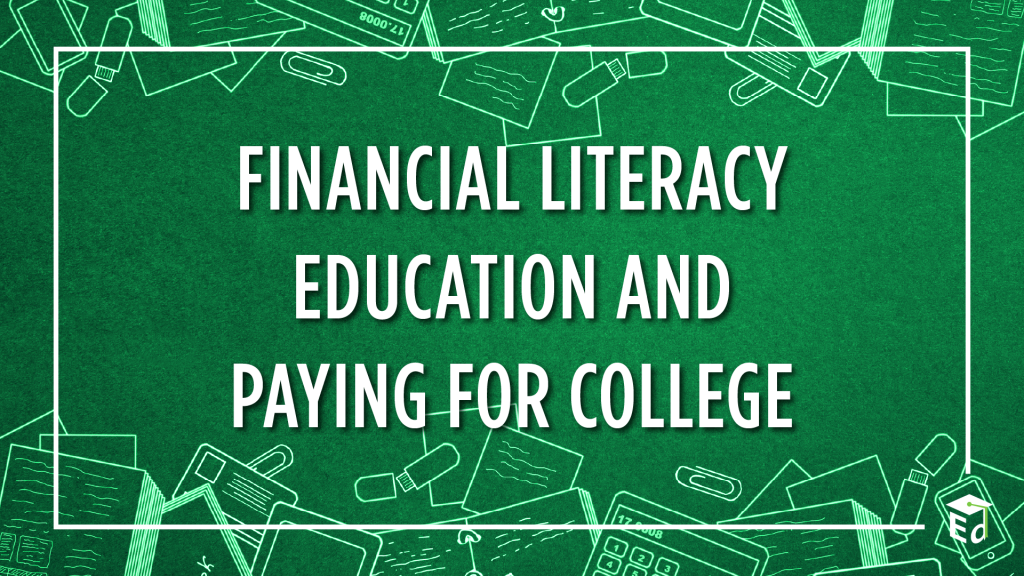Financial Literacy Education and Paying for College

President Biden issued a proclamation deeming April 2021 as National Financial Capability Month. This communication emphasizes the benefits of financial capability, the value of financial literacy, and the importance of access to financial resources. Understanding personal finance topics such as savings, loans, and investments is seldom a straightforward task, especially in the context of paying for college. Subjects, such as borrowing, can be complex for incoming postsecondary students to fully grasp. With the notable year-over-year rising cost of pursuing higher education, some students may be left with a large amount of debt and regrets about how they chose to finance their college education. According to Teach for America, a recent survey suggests that 53% of college students said that they felt less prepared to manage their money than to face any other challenge associated with college. So, how can postsecondary student’s financial literacy be improved and regrets about financing their education minimized? One solution to consider is effective financial literacy education.
According to the Financial Literacy and Education Commission’s 2019 Best Practices for Financial Literacy at Institutions of Higher Education report, effectively engaging students and providing clear, timely, and customized information about student borrowing could be keys to reducing poor financial outcomes. Individuals who receive personal finance education in line with their goals may be more likely to retain the information and use it to make informed decisions. Capitalizing on motivation by providing relevant personal finance education to students at postsecondary institutions makes it more likely that they will put that knowledge to good use. In addition, this report puts emphasis on the significance of choice of major and graduation. Early decisions, like choosing a major, and equating that field’s expected return with the cost of attendance could save some student loan borrowers from default.
Many institutions of higher education already have some type of financial education initiatives in place. At my school, the University of Central Florida, there is a program called Centsible Knights. In addition to having a clever name, this program provides students with the information that they need to enhance their knowledge of personal finance and to make strong financial decisions. The scope of topics covered during meetings range from basic borrowing information to how to file taxes and invest early. However, the burden for providing effective financial literacy education doesn’t just fall on schools. Organizations like the Higher Education Financial Wellness Alliance (HEFWA) bring together professionals and seek to inform national conversations and public policy in the financial wellness field. HEFWA’s efforts are dedicated to helping develop strong financial habits for students by promoting responsible college financing and giving students skills they need to succeed financially while they are in school and after they have graduated.
As an intern for Federal Student Aid (FSA), I have had an inside look at some of the tools and resources that the agency has to offer. FSA is doing their part to provide high-quality information to assist students in more informed decision-making surrounding financing their college education. A few of these resources include:
College Scorecard: The U.S. Department of Education’s College Scorecard is an excellent way to compare colleges and universities to one another to find a student’s best fit. Using the College Scorecard, you can compare side-by-side information on costs, graduation and retention, financial aid, and many more statistics for each college. The information is comprehensive, and the scorecard even lists fields of study and expected salary after completion.
Annual Student Loan Acknowledgement: Whether you are a first-time federal borrower or have existing federal student loans, knowing your balance, and understanding your responsibility and repayment options is important. Loan acknowledgement is a good reminder that borrowing has a direct impact on one’s financial future.
Loan Simulator: Sometimes understanding repayment options and making decisions about federal loans can be confusing or difficult for borrowers. FSA’s loan simulator is a tool that can help borrowers make decisions about repayment strategy and whether to consolidate their loans. Also, it has a feature that individuals can use to simulate borrowing more federal funds. This can be helpful for students who need to borrow additional money for education or someone who might be seeking to return to college.
Overall, choosing how to pay for college can be tricky, and unfortunately there is not a one size fits all solution. However, there are many high-quality resources available to students to help them make strong financial decisions. Places like FSA’s StudentAid website can help with understanding costs and federal borrowing, and many colleges and universities have financial wellness resources available to students who attend at no additional cost. It’s up to each student to take ownership of their finances and make informed decisions on how to fund their education. Developments in the field of financial literacy education are made frequently, and I am personally excited to see how these resources continue to develop and provide guidance to students.
Sean Cannon is an intern for Federal Student Aid under the Virtual Student Federal Service program. He is currently a senior economics student at the University of Central Florida and will be pursuing a Master’s in Applied Economics at Florida State University.
Published at Fri, 30 Apr 2021 13:50:50 +0000
Article source: https://blog.ed.gov/2021/04/financial-literacy-education-and-paying-for-college/